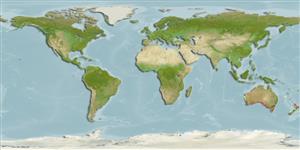>
Kurtiformes (Nurseryfishes, cardinalfishes.) >
Apogonidae (Cardinalfishes) > Apogoninae
Etymology: Siphamia: A Swazi word, siphama, for a fish.
More on author: Castelnau.
Environment: milieu / climate zone / depth range / distribution range
Ecologie
marien; brak water benthopelagisch; diepte 0 - 7 m (Ref. 57178). Temperate; 25°S - 45°S
Eastern Indian Ocean: endemic to southern Australia, from Shark Bay, Western Australia to Byron Bay, New South Wales.
Grootte / Gewicht / Leeftijd
Maturity: Lm ? range ? - ? cm
Max length : 5.0 cm SL mannelijk / geslacht onbekend; (Ref. 26498)
Korte beschrijving
Morfologie | Morfometrie
Dorsale stekels (totaal): 7; Dorsale zachte stralen (totaal): 8; Anale stekels 2; Anale zachte stralen: 8 - 9. This species is distinguished by the following characters: D1 VI, D2 I,8 (rarely 7 or 9 soft rays); A II,8-9; pectoral fin rays 12-14, unbranched and compressed distally; tubed lateral-line scales 22-23; median predorsal scales 4-5; total gill rakers 4-6 + 14-16, developed gill rakers 1-3 + 13-16 = 15-18; gill rakers on ceratobranchial 9-10; body relatively slender, depth 3.2-4.8 in SL, and body width 1.6-1.8 in the depth; eye diameter 3.2-3.7 in HL; first dorsal spine 1.1-1.3 in second spine; second dorsal spine 2.6-3.6, spine of second dorsal fin 5.1-6.7, and second anal spine 6.0-7.4, all in
head length (HL); pectoral-fin length 5.8-6.7 and pelvic-fin length 5.7-6.1 in SL; caudal-peduncle length 1.05-1.4 in distance between pelvic spine insertion and anal-fin origin; preopercular edge and ridge smooth, with the ventral edge weakly ossified and usually slightly crenulate; palatines with 1-3 series of small teeth; first infraorbital pore a complex of about 7 small pores; scales large, mostly ctenoid; tubed lateral-line scales with vertical series of papillae; the tip of light organ on each side of tongue bound by membrane (Ref. 90035).
Benthic species (Ref. 75154) which occurs over soft bottom in coastal embayments and in the lower reaches of estuaries (Ref. 33616). It is found usually in schools near kelp or seagrass beds of Zostera or Posidonia at depths of 1-10 m (Ref. 90035).
Levenscyclus en paargedrag
Maturiteit | Voortplanting | Paaien | Eieren | Fecunditeit | Larven
Mouthbrooders (Ref. 240). Distinct pairing during courtship and spawning (Ref. 205). Adults in South Australian waters have been observed brooding eggs in January (Ref. 33616).
Gon, O. and G.R. Allen, 2012. Revision of the Indo-Pacific cardinalfish genus Siphamia (Perciformes: Apogonidae). Zootaxa 3294:1-84. (Ref. 90035)
Status op de Rode Lijst van het IUCN (Ref. 130435)
Gevaar voor de mens
Harmless
Gebruik door de mens
Meer informatie
ReferentiesAquacultuurAquacultuurprofielKweeklijnenGeneticaElectrophoresesErfelijkheidZiektesVerwerkingNutrientsMassaconversie
Tools
Speciale rapporten
Download XML
Internetbronnen
Estimates based on models
Preferred temperature (Ref.
123201): 15.3 - 22, mean 17.8 °C (based on 286 cells).
Fylogenetische diversiteitsindex (Ref.
82804): PD
50 = 0.5000 [Uniqueness, from 0.5 = low to 2.0 = high].
Bayesian length-weight: a=0.01479 (0.00690 - 0.03171), b=3.09 (2.91 - 3.27), in cm total length, based on LWR estimates for this (Sub)family-body shape (Ref.
93245).
Trofisch niveau (Ref.
69278): 3.4 ±0.5 se; based on size and trophs of closest relatives
Weerstandsvermogen (Ref.
120179): Hoog, minimale populatieverdubbelingstijd minder dan 15 maanden (Preliminary K or Fecundity.).
Fishing Vulnerability (Ref.
59153): Low vulnerability (10 of 100).
Nutrients (Ref.
124155): Calcium = 171 [83, 476] mg/100g; Iron = 0.735 [0.314, 1.596] mg/100g; Protein = 17.7 [16.3, 19.1] %; Omega3 = 0.523 [0.170, 1.648] g/100g; Selenium = 9.35 [2.99, 29.26] μg/100g; VitaminA = 15.4 [2.9, 73.9] μg/100g; Zinc = 1.66 [0.94, 2.87] mg/100g (wet weight);
